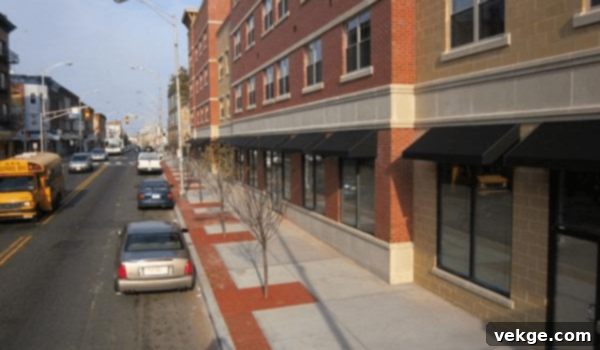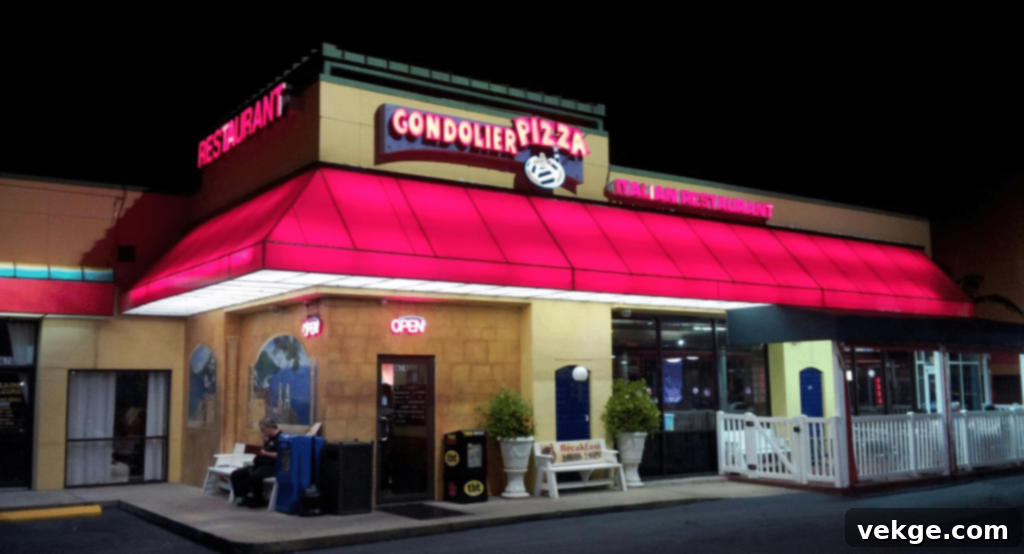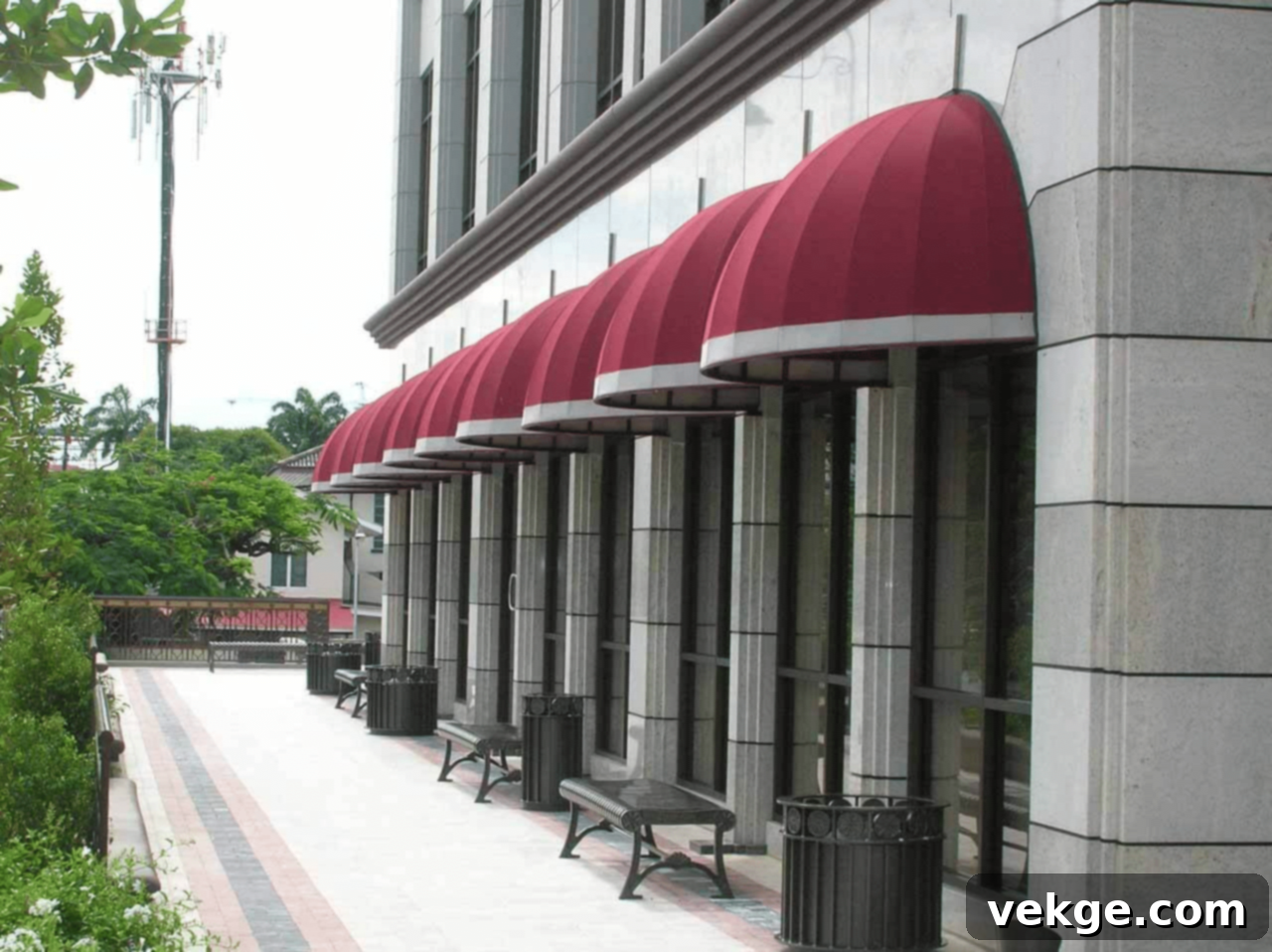Elevate Your Business: The Ultimate Guide to Commercial Awnings, Types, Designs, and Sustainable Benefits
Commercial awnings are much more than just decorative elements; they are a strategic investment for any business, offering a powerful blend of functionality, aesthetics, and sustainability. From providing essential shelter against diverse weather conditions like intense sun or heavy rain to significantly enhancing a building’s architectural style and overall curb appeal, awnings play a pivotal role in creating inviting and efficient commercial spaces.
For business owners looking to optimize their office buildings, storefronts, patios, or other vital outdoor areas and building entrances, modern commercial awnings present a versatile and impactful solution. This comprehensive guide will delve into the various types of commercial awnings available, explore their diverse designs and styles, and highlight how these practical additions contribute to more sustainable and energy-efficient business operations.
Types of Commercial Awnings: Choosing the Right Material for Your Business
Selecting the appropriate commercial awning material is crucial for maximizing its aesthetic appeal, energy efficiency, and long-term durability. Each material offers unique advantages tailored to different business needs, architectural styles, and environmental conditions. Here are the most common types of commercial awnings:
Metal Awnings: Durability Meets Modern Design
Crafted from robust materials like aluminum, steel, and occasionally copper for a distinct look, metal awnings stand out for their exceptional durability and resistance to harsh weather. They are engineered to withstand heavy rain, significant snow loads, strong winds, and extreme temperatures, making them an ideal choice for commercial buildings requiring minimal maintenance and maximum resilience.
Beyond their strength, metal canopies offer extensive customization options. Businesses can select from a vast array of colors to perfectly match their brand identity, and they can be custom-fabricated to meet specific building codes, structural requirements, and aesthetic preferences. Often seen over building entrances, long walkways, or used as prominent signage placements, metal awnings provide a sleek, modern, and enduring solution that effortlessly combines functionality with a sophisticated architectural statement.
Canvas Awnings: Classic Charm with Modern Performance
Canvas awnings, made from either natural fibers or advanced synthetic fabrics like solution-dyed acrylics (e.g., Sunbrella), provide a softer, more traditional aesthetic. Modern canvas materials are engineered with advanced treatments, offering enhanced water, UV, and mildew resistance without sacrificing their often eco-friendly properties or breathable nature. This ensures they remain vibrant and functional for years.
Known for their remarkable aesthetic versatility, fabric awnings are available in an extensive palette of colors, patterns, and textures, allowing businesses to create a unique visual identity. They are particularly favored by cafes, boutiques, and establishments seeking to evoke a warm, inviting, and classic appeal while benefiting from an energy-efficient solution that helps regulate indoor temperatures by blocking solar heat gain. Canvas awnings beautifully blend style, sustainability, and comfort.
Vinyl Awnings: High Performance and Easy Maintenance
Vinyl awnings are celebrated for their exceptional durability and impressive resistance to various environmental elements, including mold, mildew, fading, and general wear from harsh weather. Their non-porous surface makes them remarkably easy to clean and maintain, requiring minimal upkeep to retain their pristine appearance. This characteristic makes vinyl awnings an excellent choice for outdoor installations such as covered walkways, expansive dining areas, or high-traffic commercial zones.
A significant benefit of vinyl awnings is their low maintenance profile, which translates into long-term savings and hassle-free operation. They often come with inherent fire-retardant properties, making them suitable for environments where safety regulations are strict, such as commercial kitchens or public gathering spaces. Vinyl also offers excellent graphic application capabilities, making it easy to incorporate branding and promotional messages. Businesses seeking a cost-effective, attractive, and robust solution to enhance their outdoor areas will find vinyl awnings an outstanding investment.
Acrylic Awnings: Superior UV Protection and Color Vibrancy
Acrylic awnings are engineered to provide superior protection against harmful UV rays while maintaining excellent breathability. This unique combination makes them an ideal choice for retractable systems, such as lateral arm awnings or drop-arm commercial awnings, where ventilation and ease of operation are key. Acrylic fabrics are highly resistant to fading, ensuring that their vibrant colors and crisp designs remain fresh and appealing over time, even under prolonged sun exposure.
Available in a wide variety of designs, textures, and vivid colors, acrylic awnings can complement almost any architectural style, from classic to contemporary. They are particularly well-suited for storefronts, office buildings, and commercial canopies where maintaining a high-quality appearance and protecting interiors from sun damage are paramount. For businesses seeking a high-quality awning that perfectly blends advanced function with enduring style, acrylic awnings offer an elegant and practical solution.
Wood Awnings: Natural Beauty and Architectural Harmony
Wood awnings introduce a rustic, natural, and inherently warm aesthetic to commercial spaces. They are often chosen by businesses aiming to create an organic, eco-friendly, or historically sympathetic appearance that integrates seamlessly with natural color schemes and other sustainable materials. Common woods used include cedar, redwood, or treated pine, each offering distinct grains and finishes.
While wood awnings do require regular maintenance, such as sealing, staining, or painting, to protect against moisture, UV damage, and pests, their unique, natural look significantly enhances specific architectural styles like Craftsman, Farmhouse, or contemporary organic designs. They can be custom-built to perfectly fit specific building entrances, windows, or outdoor dining spaces, offering a truly bespoke and inviting charm that synthetic materials cannot replicate. For businesses prioritizing a connection to nature and a distinctive, handcrafted feel, wood awnings are an unparalleled choice.
Design & Styles of Commercial Awnings: Crafting Your Business’s Identity
The design and style of a commercial awning play a critical role in defining a business’s exterior aesthetic, drawing in customers, and providing practical benefits. The right design can dramatically increase curb appeal and enhance the functionality of your space, delivering both visual impact and practical utility. Below is a concise overview of different designs available for commercial awnings, each suited for distinct architectural expressions and business needs.
Dome Awnings: Elegant Curves and Inviting Entrances
Dome awnings are characterized by their distinctive rounded or convex shape, which creates an elegant, classic, and highly inviting look. They are frequently installed above windows or doorways of boutiques, restaurants, and professional offices, instantly adding a touch of sophistication and softness to the building’s facade. Beyond their undeniable aesthetic appeal, dome awnings offer practical shading benefits, effectively protecting entrances from direct sunlight and rain.
Their curved design is particularly efficient at facilitating excellent water runoff, preventing water from pooling on the surface during heavy rainstorms and directing it away from the entrance. This not only keeps the area dry but also helps maintain the awning’s integrity over time. Dome awnings are a timeless choice for businesses aiming to create a welcoming and refined first impression.
Concave Awnings: Distinctive Inward Curves for Modern Elegance
Concave awnings are defined by their unique inward curve, presenting a visually intriguing and eye-catching appearance. This innovative design adds an immediate touch of modern elegance and architectural sophistication, making concave awnings a popular selection for high-end retail stores, contemporary boutique hotels, and luxury commercial restaurants that wish to stand out.

While providing ample shade, the concave shape also allows for a unique filtering of light, creating a soft, inviting, and distinctive atmosphere around the building entrance. Furthermore, the inward curve is highly effective in directing rainwater away from the building’s facade, significantly reducing the risk of water damage to doors, windows, and surrounding structures. They are a statement piece that combines artistic design with practical functionality.
Convex Awnings: Bold Statements and Maximum Visibility
As their name suggests, convex awnings feature a prominent outward curve, generating a bold, dynamic, and highly visible appearance. These awnings are an excellent choice for commercial settings where businesses aim to make a strong visual impact and capture immediate attention from passersby. The distinctive shape naturally draws the eye, making the establishment more noticeable.

The convex design is particularly effective for lively storefronts, bustling coffee shops, or vibrant restaurants where creating a memorable, inviting, and prominent facade is essential for attracting and engaging customers. They offer expansive surface area for branding and signage, further enhancing a business’s presence. Convex awnings are about making a clear and confident statement, enhancing both visibility and architectural interest.
Shed Awnings: Versatile Coverage with Classic Simplicity
Shed awnings are renowned for being one of the most versatile and widely adopted awning designs in commercial environments. Characterized by their straightforward, sloped roof-like structure, shed awnings provide exceptional and reliable coverage for a wide array of spaces. This includes large expansive windows, pedestrian walkways, extended outdoor patios, and various building entrances.

Shed awnings can be installed as fixed structures for permanent shade or as retractable units for flexible coverage. Their simple yet highly effective design makes them an ideal choice for businesses that prioritize practical, functional shading solutions while still desiring an elegant addition to their building’s exterior. The inherent slope is also incredibly effective for efficient rainwater runoff, ensuring that water easily slides off, preventing accumulation and protecting the areas below.
Illuminated Awnings: 24/7 Visibility and Enhanced Branding
Illuminated awnings ingeniously merge traditional awning design with integrated lighting features, ensuring that a business’s facade remains highly visible, attractive, and functional both day and night. These awnings often incorporate LED lighting, which is energy-efficient and offers a wide range of color and brightness options, allowing for dynamic branding effects.

The built-in illumination transforms the awning into a powerful marketing tool, making the building more inviting, easier to spot from a distance, and enhancing security after dark. This is particularly crucial for businesses situated in busy urban areas, high foot traffic zones, or commercial districts where nighttime visibility is paramount for attracting customers and maintaining a strong presence. Illuminated awnings elevate branding and ensure a business stands out around the clock.
Wing Awnings: Sleek, Modern, and Architecturally Striking
Wing awnings boast a sleek, contemporary design characterized by sharp lines and distinctive angles. This modern aesthetic provides optimal shade solutions, particularly for larger windows and expansive glass facades common in contemporary commercial architecture. Unlike more traditional awning styles, wing awnings are designed to complement minimalist and cutting-edge building designs, offering a sophisticated edge.
Their angular structure delivers both compelling style and superior practicality. They are highly effective in reducing solar heat gain without obstructing views, allowing natural light to filter in while mitigating glare and heat buildup inside. Often constructed from durable materials like acrylic or metal, wing awnings are weather-resistant, easy to maintain, and represent a forward-thinking choice for businesses looking to project a modern, efficient, and architecturally integrated image.
Beyond Shade: Comprehensive Benefits of Commercial Awnings
While providing shade and shelter is their primary function, commercial awnings offer a multitude of advantages that significantly impact a business’s operations, appeal, and bottom line. These benefits extend far beyond mere protection from the elements.
Enhanced Curb Appeal & Brand Visibility
A well-chosen awning instantly elevates a building’s curb appeal, making it more attractive and inviting to potential customers. Awnings can be customized with specific colors, logos, and branding elements, acting as a prominent visual marker that reinforces your business’s identity and helps it stand out in a competitive commercial landscape. This enhanced visibility translates directly into greater brand recognition.
Improved Customer Comfort & Experience
Awnings create comfortable outdoor spaces, protecting customers from intense sun, wind, or sudden rain showers. This can extend the usability of outdoor seating areas for restaurants and cafes, provide a more pleasant waiting area for clients, or simply make the entrance to your business more welcoming. A comfortable experience encourages longer stays and repeat visits.
Interior Protection & Asset Longevity
By blocking direct sunlight, awnings significantly reduce the amount of harmful UV radiation entering your premises. This protection prevents premature fading, cracking, and deterioration of interior furnishings, merchandise displays, flooring, and artworks. Extending the lifespan of these valuable assets reduces the need for frequent replacements, saving your business money in the long run.
Increased Usable Space
Awnings effectively transform previously exposed outdoor areas into functional and comfortable extensions of your commercial space. Patios, walkways, and even certain window areas become more usable, whether for additional seating, product displays, or simply creating a more expansive and inviting environment. This maximizes your property’s potential and operational footprint.
Eco-Friendly Effects of Awnings: Sustainable Solutions for Your Business
Beyond their visual and functional benefits, commercial awnings offer significant eco-friendly advantages, playing a crucial role in promoting energy efficiency and fostering overall building sustainability. They are a simple yet powerful tool for businesses aiming to reduce their environmental footprint and operational costs.
-
Natural Cooling & Energy Efficiency
Awnings naturally create cooler interior spaces, particularly in office buildings and commercial establishments with large windows that receive significant solar exposure. By blocking up to 77% of solar heat gain through windows, awnings dramatically reduce the load on air conditioning systems during warmer months. This natural cooling effect directly translates into lower energy consumption, significantly reducing electricity bills and decreasing a business’s overall carbon footprint. Choosing awnings is a proactive step towards achieving a more energy-efficient and environmentally responsible building operation.
-
Protecting Interiors and Reducing Waste
Awnings act as a crucial shield for interior surfaces near windows, guarding against the damaging effects of direct sunlight. Constant exposure to UV rays can lead to premature fading, cracking, and deterioration of expensive interior furnishings, including wood floors, leather seating, fabrics, and displayed merchandise. By extending the lifespan of these interior assets, awnings reduce the need for frequent repairs and replacements, thereby contributing to less waste and promoting a more sustainable approach to property management.
-
Sustainable Material Choices and Longevity
Many modern awning materials, particularly certain metals like aluminum, are highly recyclable and have long lifespans, contributing to reduced resource consumption. Fabric awnings can also be made from durable, long-lasting materials that are designed to resist wear and tear, further extending their utility and minimizing the need for early replacement. Investing in quality awnings is an investment in durable, sustainable infrastructure.
Factors to Consider When Choosing Your Commercial Awning
Selecting the perfect commercial awning requires careful consideration of several key factors to ensure it meets your specific business needs, budget, and aesthetic goals. Making an informed decision will maximize the benefits and longevity of your investment.
-
Business Type and Aesthetic Goals
The nature of your business (e.g., restaurant, retail, office, salon) and the desired aesthetic (e.g., modern, rustic, elegant) will heavily influence material and design choices. An awning should complement your brand identity and architectural style.
-
Climate and Weather Conditions
Consider your local climate. Does your region experience heavy snow, strong winds, intense sun, or frequent rain? The material’s durability and structural design must be appropriate for prevailing weather to ensure safety and longevity.
-
Budget and Longevity
Establish a realistic budget that accounts for the initial purchase, installation, and potential long-term maintenance. While some materials have higher upfront costs, their superior durability and lower maintenance needs can result in greater savings over their extended lifespan.
-
Maintenance Requirements
Different materials require varying levels of maintenance. Metal and vinyl typically demand less upkeep than wood or some fabric types. Assess your business’s capacity for regular cleaning and maintenance to choose a practical option.
-
Local Regulations and Permits
Before installation, research local zoning laws, building codes, and any specific regulations for commercial signage or exterior modifications, especially in historic districts. Permits may be required.
-
Fixed vs. Retractable
Decide whether you need a permanent shade solution (fixed) or the flexibility to extend and retract the awning as needed (retractable). Retractable awnings offer versatility but often come at a higher cost and may require more operational maintenance.
-
Branding and Customization
Consider the potential for custom colors, graphics, and logos to integrate your awning seamlessly into your brand marketing strategy. Many materials offer excellent opportunities for bespoke branding.
Conclusion: A Smart Investment for a Sustainable Future
Commercial awnings are far more than just a stylish architectural feature; they represent a practical, versatile, and eco-friendly addition to any business space. From providing essential shelter and enhancing visual appeal to delivering significant energy savings and prolonging the life of your interior assets, their benefits are multifaceted and profound.
As we’ve explored, awnings come in a diverse array of materials, each presenting unique advantages tailored to specific needs: the robust durability of metal, the classic charm of canvas, the easy maintenance of vinyl, the UV protection of acrylic, and the natural elegance of wood. Coupled with an exciting range of design options—including the sophisticated curves of dome and concave styles, the bold statement of convex, the versatile simplicity of shed, the dynamic visibility of illuminated, and the modern lines of wing awnings—businesses have unparalleled flexibility to create a truly distinctive and functional exterior.
Ultimately, investing in the right commercial awning is a cost-effective solution for sustainable design. They actively help reduce cooling costs, provide invaluable protection for interiors, and make a tangible contribution to overall energy efficiency, aligning your business with modern environmental responsibility. If you’re contemplating a facelift for your commercial spaces or seeking to enhance both functionality and sustainability, the insights shared here offer a solid foundation for making an informed decision. Good luck with your enhancement project!
